Supermicro SYS-110A-16C-RN10SP Topology
The block diagram for the system is the same as the motherboard. In one sense, it is extremely simple, with almost everything hanging off the FCBGA2106 SoC. On the other hand, it shows a bit of the chip’s internal workings. For years, Intel’s Atom and Xeon D lines have integrated PCH functionality. Here we can see some of the PCIe Gen2 lanes, and presumably the SATA II lanes going to the PCH IP block. For a 10nm SoC, it feels almost strange to see a lower-speed PCH I/O block.
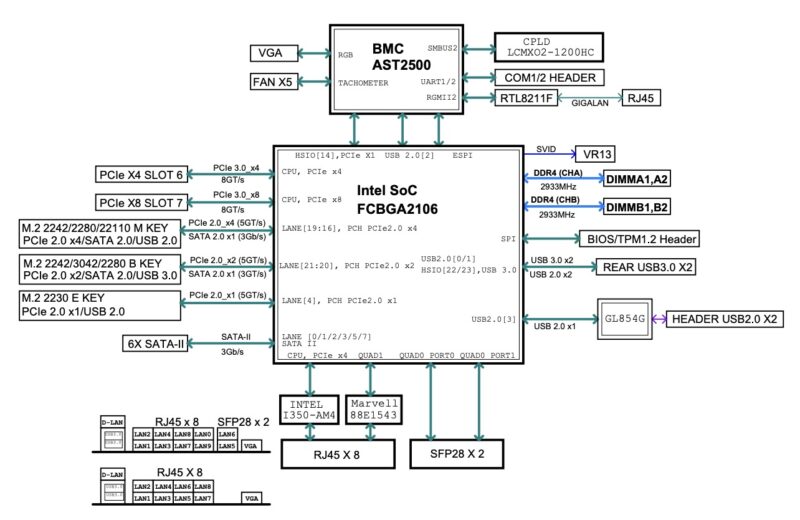
Here is what a test system looks like from a topology standpoint so you can see how the sixteen E-cores are arranged in 4-core clusters and how the onboard devices are enumerated.
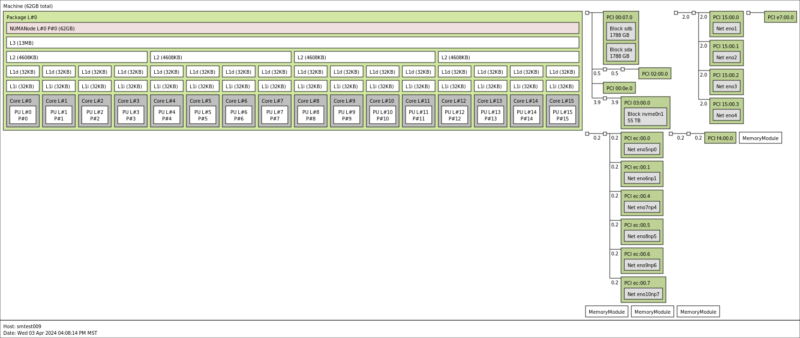
A surprising amount is happening with the SoC.
Supermicro SYS-110A-16C-RN10SP Management
Of course, the SYS-110A-16C-RN10SP has the Supermicro A3SSV-16C-SPLN10F onboard. As a result, it has out-of-band management via an ASPEED AST2500 BMC.
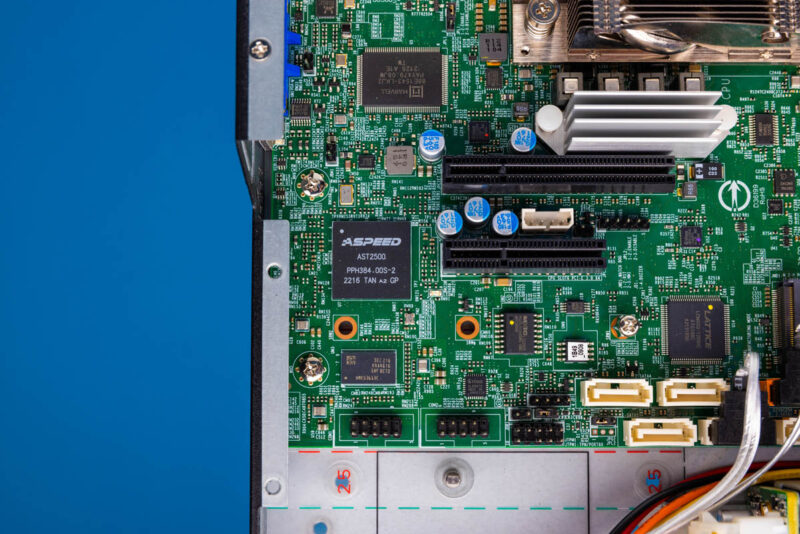
In the interest of brevity, the Supermicro IPMI/ Redfish web management interface is what we would expect from a Supermicro server at this point.
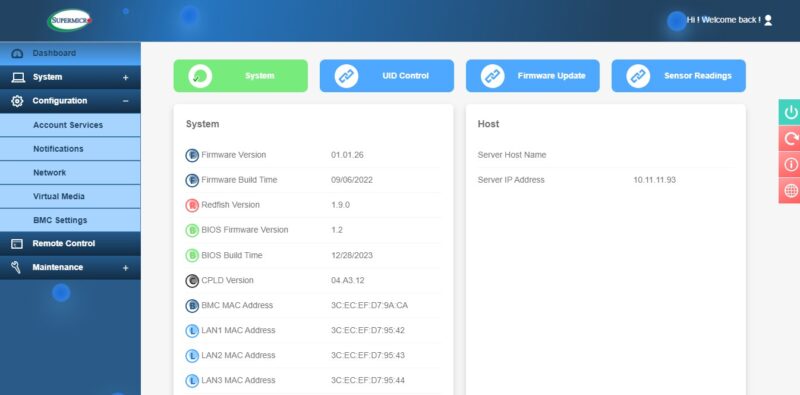
Of course there are features like the HTML5 iKVM as we would expect, along with a randomized password. You can learn more about why this is required so the old ADMIN/ ADMIN credentials will not work in Why Your Favorite Default Passwords Are Changing.
Next, let us talk about performance.
Intel Atom P5342 Performance
Since we just reviewed, the Supermicro A3SSV-16C-SPLN10F with the same CPU and motherboard that is in this system, the performance results are the same. The Intel Atom P5342 is a 16-core processor with a L3 cache. The L3 cache was something that older generations of E-core-only Atoms did not have.
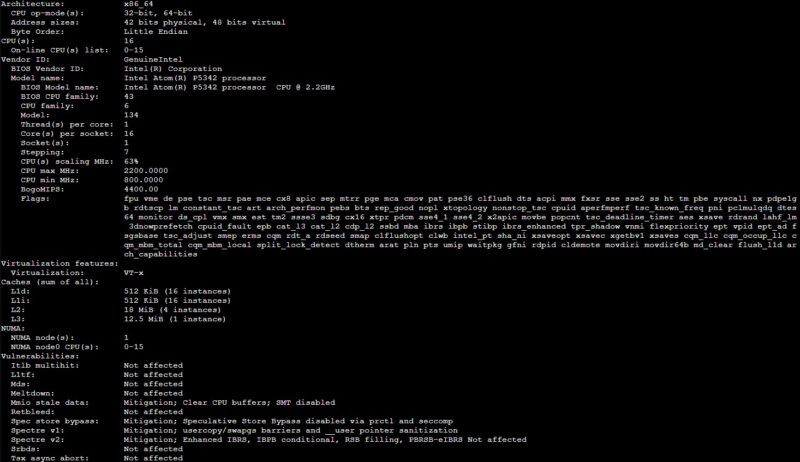
To be fair here, these are older Tremont cores. Intel’s E-cores have evolved since Snow Ridge to the point where we expect Intel Xeon 6 cores to go head-to-head with Skylake Xeon cores.
On the 25GbE and 1GbE networking, this little box had no problem pushing line rate traffic so it seemed like looking at the CPU in a bit more detail would be more exciting.
Python Linux 4.4.2 Kernel Compile Benchmark
This is one of the most requested benchmarks for STH over the past few years. The task was simple, we have a standard configuration file, the Linux 4.4.2 kernel from kernel.org, and make the standard auto-generated configuration utilizing every thread in the system. We are expressing results in terms of compiles per hour to make the results easier to read:
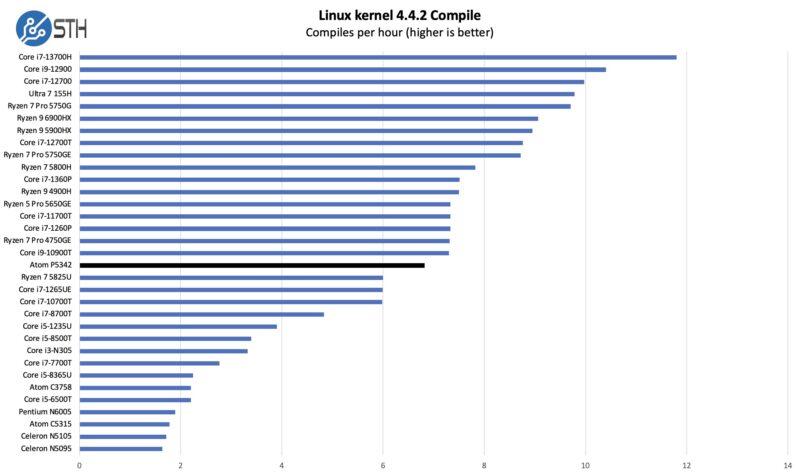
We thought this one was exceptional for the Atom P5342, but then we looked at the Intel Atom 5315 result, and it probably should have been in line with our expectations instead. This is a case where having many cores simply helps while, at the same time, the expanded cache hierarchy and improved single-core performance contribute as well.
7-zip Compression Performance
7-zip is a widely used compression/ decompression program that works cross-platform. We started using the program during our early days with Windows testing. It is now part of Linux-Bench.
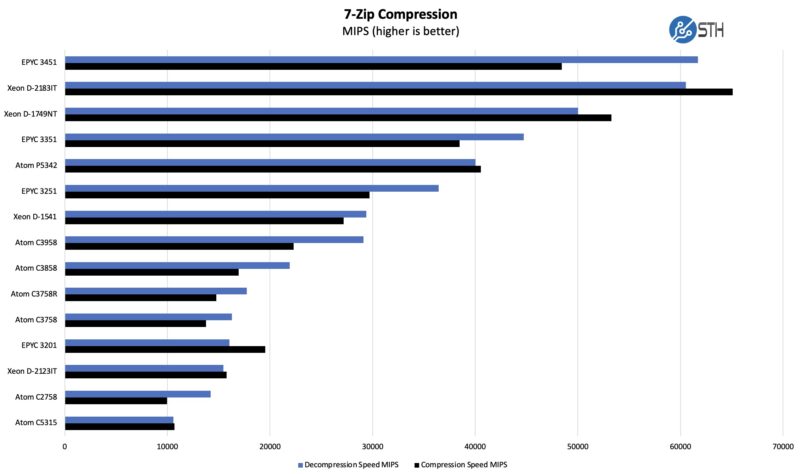
Here, we get a nice view of some popular embedded CPUs over the past seven years or so. The P5342 certainly offers a nice performance per core bump over previous Atom generations.
OpenSSL Performance
OpenSSL is widely used to secure communications between servers. This is an important protocol in many server stacks. We first look at our sign tests:
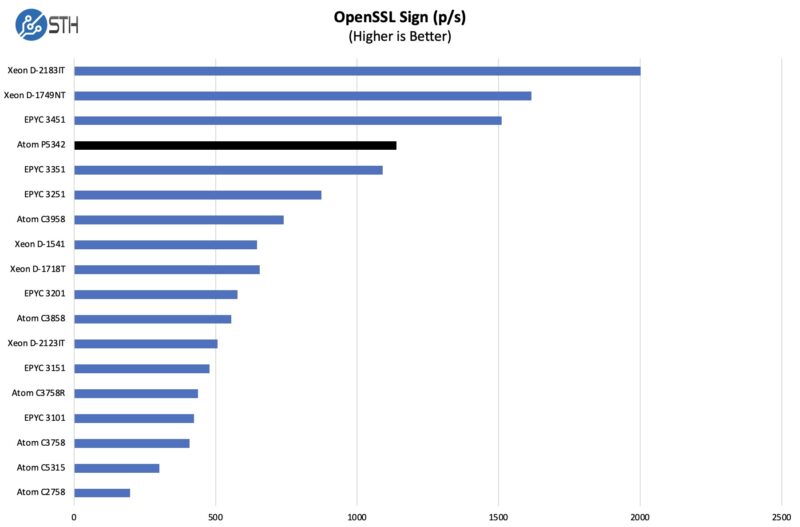
Here are the verify results:
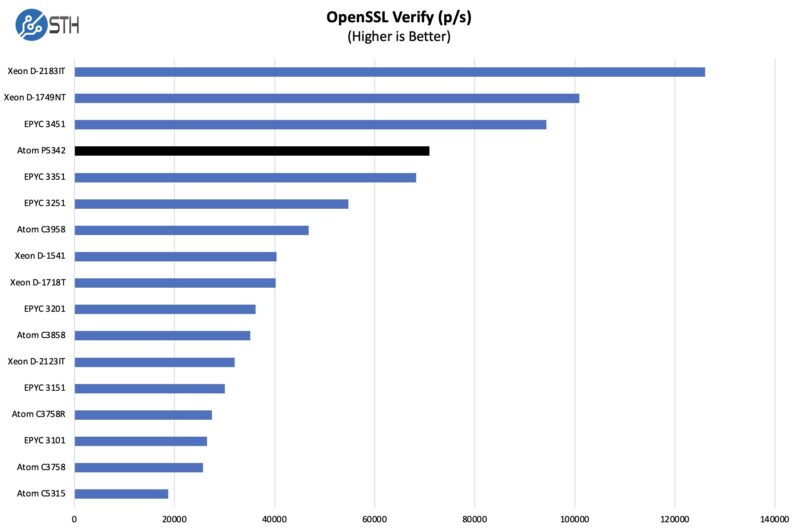
Since we are using this as a CPU benchmark, we are not using the QAT acceleration for this. That keeps the AMD results much closer than they would be otherwise. Still, if you want a good reason for the AMD EPYC 3000 line to need a refresh, this is a great example of why.
Check Your Own System with Geekbench 5 and Geekbench 6 Results
If you just want a quick-and-easy way to benchmark a system versus this, the Geekbench 5 results are really easy to compare. Here is a Geekbench 5 and a Geekbench 6 result to use. Feel free to use these results compared to other platforms in the database or that you have.
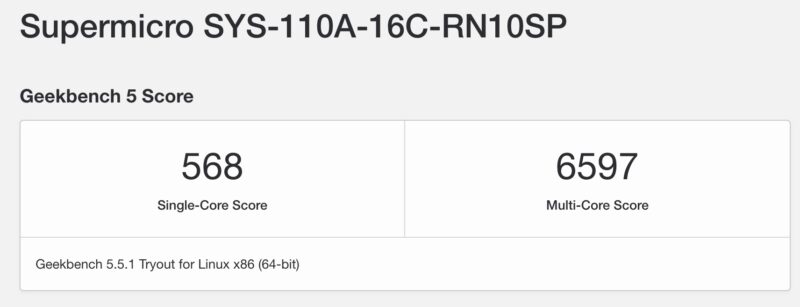
Something that is fun here is that Intel is actually very close to the NVIDIA Jetson Orin developer kit when the developer kit is in its “Max” mode. Intel focuses more on networking and network acceleration and NVIDIA more on GPU and video resources, but that was a fun one to see.
Intel QAT Supported
We are not going to deep-dive into this again for this review, but a big feature of the platform is Intel QuickAssist support. We have an Intel QuickAssist Parts and Cards by QAT Generation guide, an Intel QuickAssist in Ice Lake Servers deep-dive, an Intel Xeon D-2700 onboard QuickAssist QAT Acceleration deep-dive, and more.
Since these are designed to be networking cards, having QAT adds a big acceleration block for crypto and compression offloads that largely frees up the cores to do other work.
Next, let us get to the power consumption and noise.




For storage use, how about install a PCIe 3.0 or higher SATA/SAS card in the riser slot, assuming it will fit. Use the onboard NMvE slots as the OS/cache drives.
If such a card has external connectors then you can connect to external storage chassis via appropriate cabling.
Init7 users in Switzerland will probably snap this up as it finally looks like a homelab type box that can route 25Gbs
Interesting they’re still using wires for all the power distribution. All the Dell servers I’ve seen for years now route power on the PCB itself, and the PSUs, fans and drive bays all slot into connectors directly on the motherboard so there’s no need to route any power cables through tight spaces.
Not that there’s anything wrong with using standard connectors, it just seems like it would require more manufacturing labour and thus increased cost.
I love reading about all the cool new hardware, but how much is this is this thing? I’m guessing in 2000 – 3000 dollar range – which waaay over a normal “serving the home” budget I think. I really think these high end products should be separated to another website or something, because so many or the articles (while cool) are not serving the home anymore.
@owen I belive Patrick has answered that question many times in the future, the serve the “home” part is now way in the past. I understand that thr name servethehome.com has a brand recognition thing attached to it and this is probably why they still use it, but I would have expected a rebrand of this website at this point in time to be honest. It would take some work but maybe they can refer to the old website name for a year or two while thr new rebranded name is getting traction.
The past. Not future:-)
Malvineous that’s why Supermicro has so many SKUs and Dell has so few. They’ve got one motherboard in many form factors with wired power inputs. They’ll even keep the same case for generations. FlexATX you can get C3000, P5000, D-1500, D-2100, and there’s older C2000 I’d think. Then you can use mITX in FlexATX cases too. It’s like 100 different motherboard SKUs that can be fit into the same chassis. If you’re selling these as an OEM appliance you can get the same look and make models with different perf levels.
Owen I’ve been reading STH for years. I don’t understand that comment at all. They do lots of inexpensive gear. Lots of very expensive gear. I’d wager most here have homelabs because we use servers at work. That work gear in 2-3 years becomes homelab gear.
This is also a machine that homes with high-end internet like Korev is mentioning can use. If you’re in silicon valley there’s people spending $11,000 USD for 1m^2 on homes not even in the nicer areas or downtown San Francisco. If they’ve got fiber at a few hundred a month because US broadband prices are very high, then a $2000 machine as a firewall is not even a year’s worth of broadband service.
I’d also understand if you’re coming from a place like Albania, Rawanda, Alabama, Argentina homes are cheap, but then they’re covering cheap gear too that’s more applicable. Homes aren’t just in those cheap places.
Owen the barebones cost is $1800 retail for this edge server. By no means is that high end. If you go and get a Cisco 4200 series firewall (only the 9000 series is above that by them) you are looking at $200,000 or more for one device. For a home this would be high end but that’s it.
@owen, I believe due to the nature of readers here, it serves home IT professionals. For many, this price suffices for homelab, small business and high end home clients. I will probably end up buying a D-1700 series myself….
For provisioning a homelab, it would be interesting what the minimum spend would be for a system that can effectively route 25 gigabit Ethernet. A further study on the effects of firewall rules and operating systems at that level of performance would also be useful.
The pictures and measured time to build a Python interpreter from source are also nice.
How does a Raspberry Pi with a 2.5 gigabit USB Ethernet dongle compare? What about those router style mini PCs with multiple built-in Ethernet ports? How does increasing the complexity of the firewall rules affect these cheaper solutions?
@Owen has a reasonable point, in that this is not what most would think of as a home server; however some of my friends do have racks in their basement, and for many the office has migrated to the home as well.
Personally I’m still satisfied with the HP MicroServer Gen 8 that I got for <£200 shipped, and upgraded to 12GB RAM and an i5-3470T once it was cheaper to do so. But I find this site useful for reviews of equipment I may lease in 3-6 years' time, or possibly get second-hand.
As for a new name, may I suggest ServeTheOffice?
You know, it’d be interesting to see a series on 10+ Gbps office/lab/home routing options with performance tests. What can you really push through a Snow Ridge CPU running pfsense? What about VyOS? TNSR? How do N100s/Xeon D/Ryzen 7xxx CPUs compare?
I’m seeing it just today and felt that missing opportunity on design, if they rotated 180° the board facing all the back ports at the front (only redundant power at the back) that could have been a pretty cool all around 1U rackable multirole appliance, and with a couple of 2.5″ U.2 compatible bays, oooofff.
Eric Olson: For provisioning a homelab, it would be interesting what the minimum spend would be for a system that can effectively route 25 gigabit Ethernet.
See https://michael.stapelberg.ch/posts/2021-07-10-linux-25gbit-internet-router-pc-build/ for a good example – there are other interesting 25Gb internet posts there too
I love these short-depth supermicro servers. I’ve got a stack of them.
Those air shrouds are always mylar in this supermicro form factor. I don’t mind it. I’ve even copied the approach to make my own shrouds when building short-depth 1U servers.
@Scott Laird: I think this is brilliant idea. Seeing how these e-cores, p-cores etc. and even older “TinyMiniMicro” devices translate into real world networking performance.